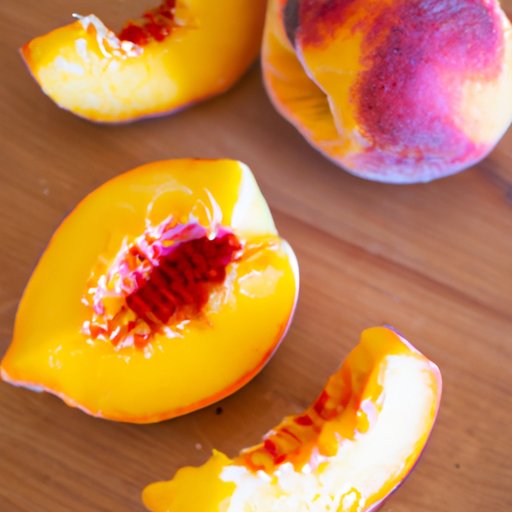
Introduction
Welcome to the world of peaches! Whether you’re a seasoned fan of this delicious fruit or a newcomer to the peach scene, this article is designed to help you make the most of this versatile fruit. In this beginner’s guide to peaches, we’ll discuss everything from how to select the perfect fruit to creative recipe ideas and wine pairings. So sit back, grab a few peaches, and let’s dive in!
The Perfect Peach: A Beginner’s Guide to Eating the Fruit
Peaches are a popular stone fruit known for their juicy, sweet flavor. There are many different varieties of peaches, each with their unique flavor and texture. Some common types of peaches include yellow peaches, white peaches, and heirloom peaches. Yellow peaches are the most commonly found peaches in grocery stores and are known for their firm texture and sweet flavor. White peaches, on the other hand, have a softer texture, lower acidity, and a more delicate flavor than yellow peaches. Heirloom peaches are a rare and more unique variety of peaches, often with a distinctive flavor and texture.
When it comes to eating a peach, it’s essential to understand the different parts of the fruit. Peaches have three primary parts: the skin, flesh, and pit. The skin is the fuzzy outer layer of the fruit and can be quite tough, especially on unripe peaches. The flesh is the juicy, sweet part of the fruit, where most of the flavor is found. The pit, also known as the stone, is a large, hard seed found in the center of the fruit.
So, how do you eat a peach? The easiest way to eat a ripe peach is simply to wash it, cut it in half, and remove the pit. You can then eat the flesh with a spoon or cut it into slices and enjoy. If you prefer, you can also peel the peach before consuming it. For unripe or firmer peaches, you may need to take extra steps to remove the skin and pit.

From Pit to Plate: How to Cut a Peach for Optimal Enjoyment
Knowing how to cut a peach is essential, especially for recipes that require the fruit to be sliced, diced, or cubed. The easiest way to cut a peach is to slice it in half, remove the pit, and then slice or dice it as needed. For recipes that call for peeled peaches, it’s best to blanch the fruit first. To do this, score an ‘X’ in the bottom of the peach and submerge it in boiling water for about 30 seconds. Remove the peach from the boiling water and immediately place it in an ice bath for several minutes. The skin should easily peel off after this.
When cutting a peach, it’s essential to keep the fruit intact to prevent it from losing its delicious juices. Start by washing the fruit and removing any stickers or debris. Then, hold the peach firmly and slice it in half down the middle, all the way around the pit. Twist the two halves in opposite directions to separate them. You can now remove the pit with a spoon or knife, depending on the ripeness of the peach.
To slice the peach, hold one half of the fruit firmly, and use a sharp knife to cut it into thin slices. If you need to dice the peach, cut it into thin slices first and then cut those slices into smaller pieces. For recipes where you need cubes, slice the peach into cubes by cutting it into thin slices, then into thin strips, and finally into small cubes.
Getting to the Sweet Spot: Tips for Choosing a Ripe Peach
One of the most important aspects of enjoying peaches is selecting ripe fruit. Unripe peaches can be quite tart and difficult to eat, while overripe peaches are mushy and lack flavor. So, how do you choose the perfect peach?
The best way to check if a peach is ripe is by its firmness. Look for peaches that are slightly soft to the touch but not mushy. The skin should also be free of blemishes, bruises, or wrinkling. The color of the peach is not always indicative of ripeness. Yellow peaches should be a deep golden color, while white peaches should have a creamy-yellow hue with a slight blush on the surface. Finally, give the fruit a sniff – it should have a sweet, fragrant aroma.
If the peaches at your grocery store or farmers’ market are not quite ripe enough, you can ripen them at home. Simply store them in a paper bag on the counter at room temperature for a day or two, checking them regularly to assess their ripeness. You can also speed up the process by adding a ripe banana or apple to the bag, which will release natural ethylene gas and speed up the ripening process.
Going Beyond the Basics: Creative Peach Recipes for Every Meal
Peaches are a versatile fruit that can be incorporated into a wide variety of recipes. Here are a few creative recipe ideas that use peaches as a key ingredient:
Peach and Yogurt Parfait:
Layer sliced peaches and your favorite yogurt in a parfait glass. Top with granola or chopped nuts for added crunch. This recipe makes for a delicious breakfast or snack.
Peach Caprese Salad:
Combine sliced peaches, fresh mozzarella, and cherry tomatoes in a bowl. Drizzle with balsamic vinegar and olive oil and add fresh basil to taste. This salad is a light, refreshing lunch or dinner option.
Peach Salsa:
Mix diced peaches, red onion, jalapeno, cilantro, and lime juice to make a fresh and flavorful salsa. Serve with tortilla chips or over grilled chicken or fish.
Pairing Perfection: How to Serve Peaches with Wine and Cheese
Peaches can be paired with a range of wines and cheeses to create a delicious appetizer or dessert. For wine pairings, stick to light-bodied, fruity options like Riesling or Chardonnay. For cheeses, try a mild, creamy cheese like Brie or goat cheese.
One great way to serve peaches with cheese is to create a charcuterie board. Arrange slices of fresh peaches, your favorite cheese, crackers, and cured meats on a platter for a simple and elegant appetizer. You can also serve grilled peaches with a dollop of goat cheese for a unique and delicious dessert option.
The Juiciest Tips for Storing Peaches for Optimal Freshness
Once you’ve selected the perfect ripe peaches, it’s essential to store them correctly to maintain their freshness and flavor. Here’s how:
If you plan to eat the peaches within a few days, store them at room temperature away from direct sunlight. To prevent bruising, store them with the stem side down. If you need to store peaches for longer, you can keep them in the fridge for up to a week. However, keep in mind that the cold temperature can affect their texture.
Peaches should be stored away from other fruits and vegetables as they can release ethylene gas, which may cause them to ripen faster than desirable. If you have excess peaches, you can also freeze or can them for later use. To freeze peaches, simply peel and slice the fruit and place it in an airtight container or freezer bag. To can peaches, peel and slice them, then pack them into jars with syrup or water
A Peachy Adventure: Exploring the Different Types of Peaches and Their Unique Flavors
Ready to take your peach game to the next level? It’s time to explore the different varieties of peaches! Some unique options include:
Donut Peaches – These small, flattened peaches have a sweet, almost tropical flavor.
Baby Gold Peaches – These tiny peaches are bursting with sweetness and are perfect for snacking or adding to salads.
O’Henry Peaches – These yellow-fleshed peaches have a distinct flavor that is both tangy and sweet. They are perfect for grilling or baking.
Once you’ve selected a few different types of peaches, it’s time to taste test! Start by cutting small pieces of each variety and tasting them side by side. You’ll love discovering the unique flavors of each type of peach.
Conclusion
There you have it! A beginner’s guide to eating, cutting, and enjoying peaches. We hope this article has helped you gain a better understanding of this delicious fruit and how to make the most of it. Whether you’re snacking on a fresh peach, making a delicious recipe, or pairing it with wine and cheese, peaches are a versatile fruit that is sure to please.





